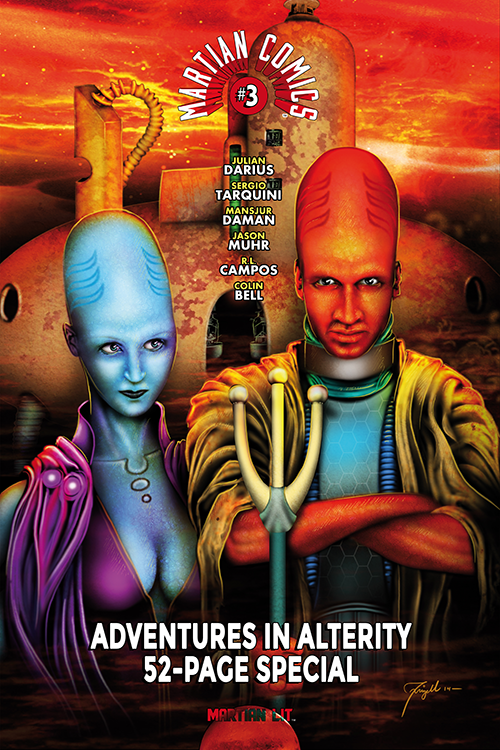Continuing our interview with Martian Comics creator and the Sequart Organization founder Julian Darius, we move from his depiction of the prophet Ezekiel to his treatment of Lazarus and of Jesus, “The Galilean”:

S&S: “Ezekiel” is followed by the longer, 11-page, “What Has Athens to Do with Jerusalem?” The title, presumably, comes from the writings of the Church Father Tertullian, yet the story focuses on Lazarus, the man Jesus resurrected, and Paul. What’s the connection between the title and the concerns of the story?
JD: The quote comes from a later period. But it’s key to the point of the story.
On the one hand, the story allows us to catch up with Lazarus, seeing how he’s evolved —
S&S: Since readers last saw him in issue #2 of Martian Comics, freshly resurrected by Jesus but, in effect, unable to fully live or rejoin what was his life.
JD: Right. Lazarus actually has a cameo in issue #1, but issue #2 is the first to have a story all his own. The idea is to follow up on the Lazarus story, because the Bible never tells us what happened to him. The point is that Jesus resurrected him, and it’s a miracle – but Lazarus is just a prop, really. He’s a demonstration of Jesus’s power. So I thought “what happened next” was an interesting idea, and I thought this tension – about how Lazarus is kind of forgotten, once he’s resurrected – should be part of the story.
So in issue #2, Lazarus is resurrected, but he’s been decaying a little, and these rural Jews of the first century, who were pretty superstitious, would have seen him as a supernatural thing. They’re scared of him, and he doesn’t look right. It’s not going to be like “Oh, Lazarus, glad you’re alive again, old chap!” No, there are going to be rumors, and any physical deformity or ailment was seen as potentially demonic or dangerous. That’s why Jesus ministering to lepers was such a thing. And in those days, you really needed a community to survive. So Lazarus is alive, but he’s kind of a pariah. And he sees how this is hurting his family – that, as he says, he’s of no use to them.
So Lazarus is kind of figuring out what being resurrected means. It’s not just that you came back to life. You’re different now. You look different, and you’re treated differently. Jesus does his miracle, and everyone’s impressed, but no one really follows up with Lazarus. There’s no post-resurrection counselors or anything.
Along with this, what does resurrection mean biologically? Does someone who’s been resurrected return to life and live out a normal lifespan, as if they hadn’t died? Do they get a week and then die again? Maybe resurrection’s not permanent! Or do they live forever? I think we usually don’t ask these kinds of questions, and it’s not a focus of these stories in the Bible, where the point is that Jesus is powerful because he resurrected someone – implicitly encouraging us to believe. We kind of assume that any bodily decay is healed as part of the resurrection, although that doesn’t necessarily follow. And I was interested in exploring all of this. My Lazarus doesn’t have his bodily decay healed, and whatever energy resurrected him is still in him. He’s immortal, although he doesn’t know it at first. He learns it in pretty dramatic fashion in that story.
Continue reading The Martian Chronicles of Julian Darius, Part II

